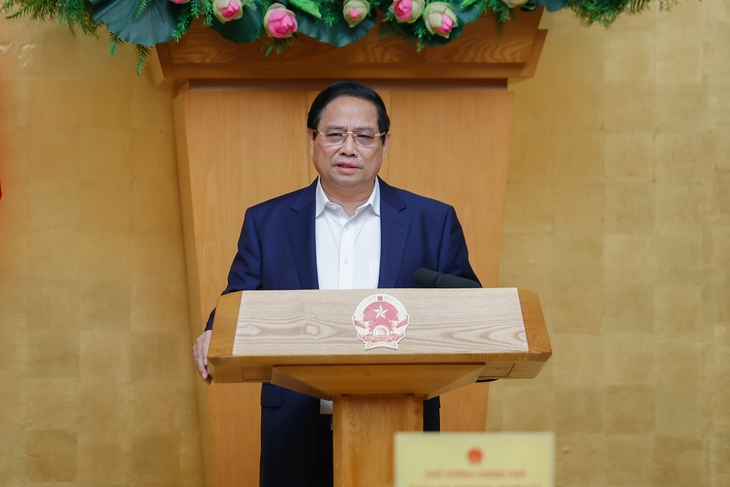Vietnamese Prime Minister Pham Minh Chinh stated during a monthly cabinet meeting on Sunday that Washington’s imposition of a 46-percent tariff on imports from Vietnam should be viewed as an opportunity for the Southeast Asian country to restructure its economy and diversify products and markets toward sustainable development.
The meeting focused on assessing the socio-economic situation in March and the first quarter of this year, outlining key tasks for April and the period ahead.
In his opening remarks, PM Chinh addressed the complex and unpredictable global developments, particularly the U.S.'s announcement of substantial reciprocal tariffs affecting Vietnam, amid escalating trade tensions that could disrupt production and supply chains.
On April 3, the U.S. administration announced a significant 46-percent tariff on imports from Vietnam, effective April 9, placing the Southeast Asian nation among those facing the steepest duties – higher than those imposed on competitors like Thailand (36 percent), Pakistan (29 percent), and the Philippines (17 percent).
Since early 2025, Vietnam has undertaken necessary measures to balance trade with the U.S., notably the recent phone discussions between Party General Secretary To Lam and President Donald Trump to enhance bilateral relations, especially in trade, PM Chinh noted.
In their conversation on Friday, Lam conveyed Vietnam's readiness to collaborate with the U.S. to reduce import tariffs on U.S. goods to zero percent.
Chinh also affirmed that Vietnamese authorities have worked on reducing import tariffs on U.S. goods and implemented other measures to mitigate the situation, including facilitating investments from foreign enterprises, particularly U.S. companies, and addressing legitimate requests from the U.S. side.
He emphasized that the current situation presents an opportunity for Vietnam to accelerate economic restructuring toward sustainability by harnessing digitalization, science and technology, and innovation.
Additionally, it is a chance to promote the restructuring of export markets and enhance product quality to access markets with significant potential, such as the Middle East, Central Asia, East Asia, South America, India, and ASEAN countries.
He called for further expansion of export markets, diversification of products, markets, and supply chains, and optimal utilization of the 17 free trade agreements and other cooperation frameworks of which Vietnam is a member.
|
|
| An overview of the government's monthly meeting chaired by Vietnamese Prime Minister Pham Minh Chinh in Hanoi, April 6, 2025. Photo: Vietnam Government Portal |
"We must position the Vietnam-U.S. trade relationship within the broader context of our trade relations with other countries and trade agreements, recognizing that while the U.S. is Vietnam's largest export market, it is not the only one," Chinh stated.
Regarding the handling of the reciprocal tariff, he directed that more diplomatic measures should be pursued to request the U.S. postpone this while negotiations are ongoing.
Furthermore, ministries and sectors should heed the business community's opinions, prioritizing national interests.
According to a White House statement released April 2, President Trump will impose a 10-percent tariff on all countries starting April 5, except for those with the largest trade deficits with the U.S., which will face individually assessed higher reciprocal tariffs, effective April 9.
Following this announcement, permanent cabinet members convened to assess the situation and propose solutions, leading to the establishment of a rapid response task force led by Deputy PM and Minister of Foreign Affairs Bui Thanh Son, Chinh told the meeting.
Deputy PM Ho Duc Phoc is scheduled to visit the U.S. on Sunday to discuss the reciprocal tariff issue with U.S. counterparts, the PM added.
Regarding domestic affairs, PM Chinh stressed the need to focus on tasks to achieve the GDP growth target of at least eight percent this year, creating momentum for double-digit growth in subsequent years.
The General Statistics Office of Vietnam reports that GDP in Q1 2025 increased 6.93 percent over the same period last year, marking the highest growth compared to Q1 figures in 2020-2025.
While the growth is encouraging, it still falls short of the 7.7 percent quarterly pace needed to hit the full-year target of eight percent GDP growth, according to the General Statistics Office.
PM Chinh urged stronger efforts to tackle challenges and deliver more robust results to ensure the country stays on track to meet its 2025 growth goals.
Like us on Facebook or follow us on X to get the latest news about Vietnam!






















































